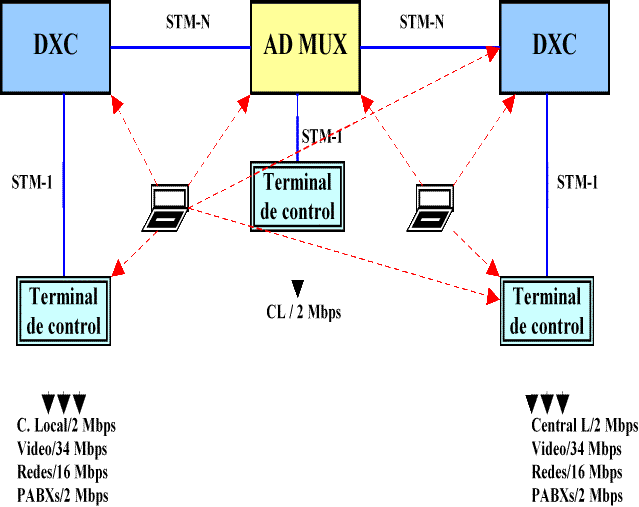|
Introduction to SDH:
Synchronous Digital
Hierarchy is an international standard for high capacity
telecommunication fiber optic networks. It is a synchronous digital
transport system aimed at providing a simpler, and more economical and
flexible telecommunication network infrastructure.
SDH is essentially a transport protocol based on a common time
reference (primary clock), which multiplexes different signals within
a common flexible hierarchy and administers their transmission
efficiently over fiber optic cable, with internal protection
mechanisms. As all network terminals have a stable reference clock,
no type of stuffing or framing bits are needed during multiplexing of
signals.
SDH is usually considered a physical transport layer
protocol and, as such, is used to carry traffic in the form of packets
of information, such as voice, video, multimedia, and data packets
such as those generated by ATM, IP,
or applications such as PDH.
To that end, its role is essentially to manage the use of fiber optic
infrastructure, which implies efficient broadband management while
carrying different types of traffic, detecting errors, and recovering
transmissions from them transparently for the higher layers.
Origin of SDH
Synchronous transmission systems were developed as a result of
operators’ need to identify solutions to, principally, the following
problems:
a)
Deployment of flexible and resistant networks;
b)
Definition of standard interfaces between the equipment
of different manufacturers;
c)
Facilitation of network interconnection between North American
and European transmission hierarchies.
In 1989, the standard culminated in ITU-T Recommendations G.707, G.708,
and G.709, which define the Synchronous Digital Hierarchy.
These recommendations define a number of basic rates of transmission
that can be used in SDH. The first is 155.52 Mbps,
normally referred to as an STM-1 (where STM means
Synchronous Transport Module). Higher transmission rates, such as
STM-4 (622.08 Mbps), STM-16 (2488.32
Mbps), and STM-64 (9953.28 Mbps), have also been
defined.
The recommendations define a multiplexing structure in which an
STM-1 signal transports or accommodates a number of lower
transmission rate signals, such as PDH signals of all levels, to
transport the old frames into a new frame, packaging them together in
its payload area, utilizing a multi-step process in a different
number of structures.
Advantages:
a) Simpler
and more flexible multiplexing and demultiplexing, enabling circuits
to be extracted and inserted without stopping the data stream,
utilizing a simple multiplexer and enabling point-to-point services to
be provided rapidly on request.
b) Ease
of migration toward higher orders of multiplexing, as they use the
same working philosophy.
c) Definition
in the standard of network administration capacity.
d) Main
hubs that enable network Operation, Administration, and Maintenance (OAM)
procedures to be improved.
e) Administration
and transport of a wide variety of fixed broadband services, such as
PDH traffic signals at 2 Mbps, 34 Mbps, and 140 Mbps, G.702,
ATM, Ethernet interfaces that take IP data or LAN data, analog
voice interfaces, and ISDN/ADSL interfaces.
f) Integrated
protection mechanisms, with automatic re-routing of traffic without
service interruption.
g) Definition
of an open standardized electrical and optical interface to permit
interconnection with other equipment.

Fig.1: Traffic access in PDH vs. SDH
Characteristics of the SDH transport network:
a) Digital
multiplexing: Analog communication signals are carried in
digital format over the network. Digital traffic may be carried much
more efficiently and it permits monitoring of errors for quality
purposes.
b) Fiber
optics: This is the physical medium commonly utilized on
today’s transport networks owing to its higher traffic transport
capacity, which tends to reduce costs associated with the transport of
traffic.
c) Protection
schemes: These have been standardized to ensure traffic
availability. In case of possible errors or fiber breakage, traffic
can be switched to an alternative route so that the end user does not
experience any disruption of service.
d) Ring
topologies: These are being increasingly deployed owing to
possible loss of connection. There is an alternative traffic route on
the other side of the ring, minimizing connections and the amount of
optical fiber deployed on the network.
e) Network
administration: Administration of such networks from a single
remote location is an important service for operators. Software has
been developed that enables all nodes and traffic routes to be
administered from a single computer. One operator may administer a
wide range of functions, such as providing capacity in response to
customer demand or monitoring of a network’s quality.
f) Synchronization:
Network operators must provide synchronized timing for all network
elements to ensure that information passing from one node to another
is not lost. Synchronization is becoming a critical point, making
SDH an ideal network philosophy.

José
Alberto Benitez Gómez
IPT - FIUNA
Center for
Technological Innovation
of the Engineering School of Paraguay
|
Additional Information: This document is part of the
material of the course "Synchronous Digital
Hierarchy" that will be held November
7 to 11, 2005
in Asunción, Paraguay, through the Regional Training
Center a: Center for
Technological Innovation of the Engineering School of Paraguay
CITEL/OEA offered 5
fellowships of the round-trip ticket. CITEC-FIUNA
will cover registration fee, materials, accommodation, meals,
transport and insurance ..
|
|

